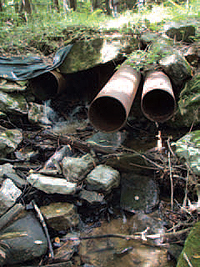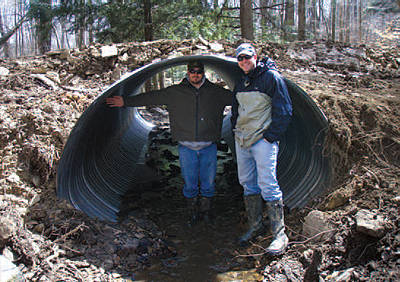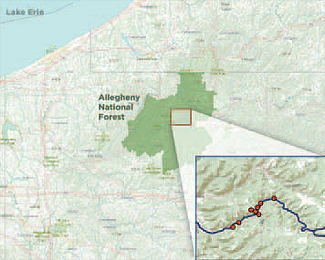WPC’s Recent Work Enhances Allegheny National Forest Watershed

Aging, undersized culverts like these were preventing aquatic species from traversing the watershed.
The Conservancy is working to enhance the East Branch Tionesta Creek watershed within the Allegheny National Forest (ANF), building on WPC’s longstanding efforts to help conserve land and water in and around the commonwealth’s only national forest. In addition to the Conservancy’s extensive work over the years along the Clarion and Allegheny rivers, which contributed to their designation as Wild and Scenic rivers, WPC played a major role in the conservation of the ANF’s Hickory Creek Wilderness area and the Allegheny River Islands Wilderness. In total, WPC’s work in the forest has protected more than 9,000 acres of land.
East Branch Tionesta Creek watershed, a major tributary to the Allegheny River, is located within the 513,279-acre national forest. The watershed, which supports naturally reproducing trout populations, is a High-Quality Coldwater Fishery, the second-highest water quality designation in the state. East Branch Tionesta Creek is open to the public for fishing and camping.
The project area, which encompasses the main stem and nine tributaries within Warren and McKean counties, was suffering from the impacts of aging, undersized culverts that were installed in conjunction with an extensive network of dirt and gravel service roads. The culverts disconnected many of the headwater areas of the tributaries from the main stem. This led to significantly impeded movement of fish and other aquatic life and segregated populations throughout the watershed. The U.S. Forest Service identified this as a top restoration priority within ANF.

WPC’s Tye Desiderio, watershed program GIS specialist (left) and Brian Neal, watershed program projects manager, helped install culverts this year that allow the streams to flow more naturally.
During the summer of 2011, WPC staff conducted biological surveys and water quality and habitat assessments above and below the existing culverts in the watershed. Among the aquatic life identified were native brook trout and wild brown trout. Seven of the nine streams surveyed had wild trout populations. Following the assessment phase, staff secured permits and selected outside contractors for the construction phase.
Between March and July of this year, WPC replaced eight culverts with much larger structures and made other improvements to the dirt and gravel road system. The undersized culverts, some as small as nine inches in diameter, were replaced with substantially larger culverts—including one that is over 11 feet in diameter and 40 feet long. In addition, large stones were strategically placed through the length of certain culverts to restructure the streambed and offer refuge for fish and other aquatic life traveling through the pipe.

WPC identified eight locations in the Tionesta Creek watershed for replacement of undersized culverts.
The result is improved water flow in the creeks and streams and reduced runoff and sedimentation that was previously causing flooding of dirt and gravels roads. “The finished product looks and acts more like a natural stream system, which is not only an ecological improvement, but also an aesthetic one,” said Kylie Maland, WPC watershed manager, Upper Allegheny & Lake Erie. “Given the results of this project, we hope to replicate it in other parts of the Allegheny National Forest.”
Post-implementation biological surveys and water quality and habitat assessment monitoring are currently underway, as are surveys in other ANF watersheds to identify native brook trout populations and determine what other culverts are disrupting aquatic life. Future restoration work will be based on those surveys. Funding for this work was provided by the National Forest Foundation and National Fuel Gas Company.
